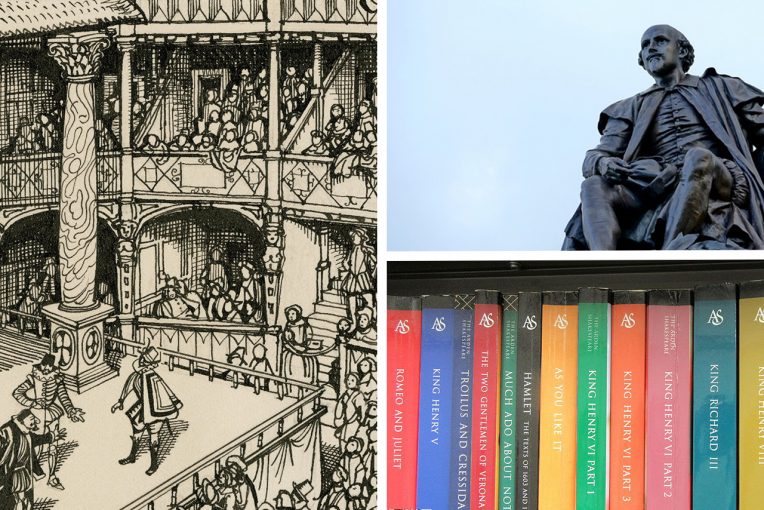The Complete Works of William Shakespeare (abridged), which will open the Illinois Shakespeare Festival’s 2022 season, attempts to present all of the Bard’s plays in a single evening. At one point, the trio of intrepid performers do some quick math to see how quickly they have to work through Shakespeare’s body of work to achieve this goal, multiplying the time it took to do Romeo and Juliet by 37. But the number they give for Shakespeare’s plays differs from other lists. If you search online, you may find different counts—38 or 39. Which one is correct? Exactly how many plays did Shakespeare write?
This seemingly simple question turns out to be hard to answer definitively. There are 36 plays collected in the First Folio, divided into 14 comedies, 10 histories, and 11 tragedies—plus Troilus and Cressida, which for some reason is not listed in the table of contents. Most modern editions of Shakespeare’s works add Pericles and Two Noble Kinsmen to this list, bringing the total to 38. However, it is likely that Shakespeare co-wrote these plays, leading some to argue they should not be included in a volume dedicated to Shakespeare’s writing. Of course, it would hardly make sense to print only the parts that Shakespeare wrote, especially when scholars disagree about the authorship of some scenes, sometimes claiming that a passage is too poorly written to be Shakespeare. But what writer always hits the mark? More recently, computer programs have been developed to calculate the probability of Shakespeare’s hand in a given passage by comparing the spelling, syntax, and other linguistic habits to text we are fairly sure Shakespeare wrote. But even this technology cannot decide whether a play should be counted in the list of Shakespeare’s complete works. Gray areas still exist. For example, some plays in the First Folio such as Timon of Athens and Henry VIII contain scenes by other playwrights. Should they be left in? And there are some plays, such as Sir Thomas More and Edward the Third, that are not commonly attributed to Shakespeare yet have parts that bear his mark. Where do we draw the line?
What determines the full catalogue seems to be based more in tradition than some objective standard. A term that could help us understand this process of setting and adjusting the boundaries of Shakespeare’s body of work is canonicity, rooted in the Greek and Hebrew word for measuring rod. Some readers may be familiar with discussions of something being “canon” for an expansive franchise such as Star Wars, spanning films, TV series, novels, comic books, video games, and other media. The purpose of distinguishing between canonical and non-canonical works is to establish a consistent timeline of events for this fictional universe.
The term canon actually comes from theology, where establishing the authority of official scripture (as opposed to apocrypha) is an important matter. Deciding what counts as a Shakespeare play could be compared to the approval of various versions of Christian Bibles by church authorities. In the second edition of The Norton Shakespeare (my preferred collection of Shakespeare’s works), the editors note that “the Folio will always remain the foundation of Shakespeare’s dramatic canon.” While there may be disagreement about adding, say, Two Noble Kinsmen or Edward the Third to the list, the 36 plays in the First Folio are securely within the canon of Shakespeare’s plays. At the same time, the process of canonicity means that these discussions can change, as cultural standards regarding authorship and artistic achievement shift over time. Historians also make the occasional new discovery, affecting the consensus on the authorship of some texts. A growing number of Shakespeare scholars regard Edward the Third as partially written by Shakespeare, whereas it was not considered part of the canon in the past.

Does this ambiguity bother you? Would it be nice to decide on a number and keep it that way? Granted, there is something comforting about having an official list. If we know exactly how many plays Shakespeare wrote, then it becomes possible to read or see them all, satisfying our completionist impulses. But when we examine the history of how Shakespeare’s plays were complied, edited, and distributed over time, the idea of “the complete Shakespeare” begins to feel like an impossible dream. I have not yet mentioned potential Shakespeare plays that have been lost (if they ever existed in the first place), such as Love’s Labour’s Won and Cardenio. These titles are often left out of the picture when we imagine Shakespeare’s work as a whole, because we cannot experience them. Perhaps it is also because they remind us that the list can never be final. Shakespeare will always be incomplete.
Did the original creators of Complete Works—Adam Long, Daniel Singer, and Jess Winfield—think about this when they titled their show back in 1987? (Also, does the script count 37 plays because that was the accepted number at the time?) I think they at least had an instinctive understanding of our desire to close the circle on Shakespeare’s oeuvre. The word “complete” has an alluring ring to it, promising everything there is to be had. It may be related to the satisfaction of having a giant tome of Shakespeare’s plays sitting on your shelf, even if the font is too small and the book too heavy to read comfortably. (I own three different versions, by the way.) But Complete Works also pokes fun at the idea of ever completely knowing Shakespeare by attempting to run through the catalogue of thirty-something plays—each boundless in its depth and richness—in a couple of hours. It would have been impossible even if they had all the time in the world. By the end, the show does not leave the audience satiated but rather craving for more Shakespeare.

